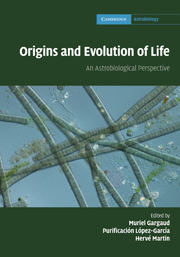Book contents
- Frontmatter
- Contents
- List of contributors
- Foreword
- Preface
- Part I What is life?
- Part II Astronomical and geophysical context of the emergence of life
- Part III The role of water in the emergence of life
- Part IV From non-living systems to life
- Part V Mechanisms for life evolution
- Part VI Life in extreme conditions
- Part VII Traces of life and biosignatures
- Part VIII Life elsewhere?
- 29 Titan and the Cassini–Huygens mission
- 30 The role of terrestrial analogue environments in astrobiology
- Index
29 - Titan and the Cassini–Huygens mission
from Part VIII - Life elsewhere?
Published online by Cambridge University Press: 04 February 2011
- Frontmatter
- Contents
- List of contributors
- Foreword
- Preface
- Part I What is life?
- Part II Astronomical and geophysical context of the emergence of life
- Part III The role of water in the emergence of life
- Part IV From non-living systems to life
- Part V Mechanisms for life evolution
- Part VI Life in extreme conditions
- Part VII Traces of life and biosignatures
- Part VIII Life elsewhere?
- 29 Titan and the Cassini–Huygens mission
- 30 The role of terrestrial analogue environments in astrobiology
- Index
Summary
Titan before Cassini–Huygens
With a diameter of 5150 km, Titan is the largest satellite of Saturn. It was discovered in 1655 by Christiaan Huygens. The period of rotation of Titan around the Sun is that of Saturn, 29.5 years. With its obliquity of 27°, Saturn has seasons, each of 7 years' duration, and Titan's seasonality is the same thanks to the close alignment of its pole with Saturn's. In addition, Titan turns around Saturn – with synchronous rotation – within 16 Earth-days, thus Titan's solid surface rotates slowly; however, its atmosphere presents a super-rotation due to strong zonal winds. Titan's mean distance from the Sun is that of Saturn's – about 9.5 astronomical units (AU). This corresponds to a received solar flux at the top of its atmosphere just slightly more than 1% of the flux at the Earth. Moreover, distant from Saturn by about 20 Saturnian radii, Titan is far enough from the giant planet to avoid interactions with the rings, but still close enough to allow its atmosphere to interact with the electrons of the magnetosphere of Saturn, which thus play a role in its chemical evolution, together with the solar photons.
Titan is the only satellite in the Solar System having a dense atmosphere. The presence of its atmosphere was suggested in 1907 by José Comas-Sola based on his observations of the centre-to-limb darkening of Titan's disk.
- Type
- Chapter
- Information
- Origins and Evolution of LifeAn Astrobiological Perspective, pp. 489 - 506Publisher: Cambridge University PressPrint publication year: 2011



